
| Home | Sources Directory | News Releases | Calendar | Articles | | Contact | |
Jellyfish
| Jellyfish | |
|---|---|
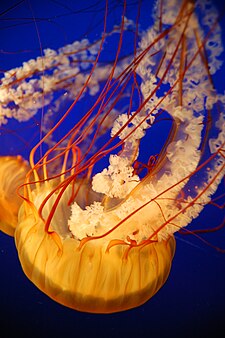 |
|
| Chrysaora fuscescens | |
| Scientific classification | |
| Kingdom: | Animalia |
| Phylum: | Cnidaria |
| Subphylum: | Medusozoa Petersen, 1979 |
| Classes | |
Jellyfish (also known as jellies or sea jellies or medusozoa) are free-swimming members of the phylum Cnidaria. Jellyfish have several different morphologies that represent several different cnidarian classes including the Scyphozoa (over 200 species), Staurozoa (about 50 species), Cubozoa (about 20 species), and Hydrozoa (about 1000'1500 species that make jellyfish and many more that do not).[1][2] The jellyfish in these groups are also called, respectively, scyphomedusae, stauromedusae, cubomedusae, and hydromedusae. All jellyfish are embodied in the Medusozoa subphylum. Medusa is another word for jellyfish, and as such is used to refer specifically to the adult stage of the life cycle.
Jellyfish are found in every ocean, from the surface to the deep sea. Some hydrozoan jellyfish, or hydromedusae, are also found in fresh water; freshwater species are less than an inch (25 mm) in diameter, are colorless and do not sting. Many of the best-known jellyfish, such as Aurelia, are scyphomedusae. These are the large, often colorful, jellyfish that are common in coastal zones worldwide.
In its broadest sense, the term jellyfish also generally refers to members of the phylum Ctenophora. Although not closely related to cnidarian jellyfish, ctenophores are also free-swimming planktonic carnivores, are generally transparent or translucent, and exist in shallow to deep portions of all the world's oceans.
Lion's Mane Jellyfish are the largest known jellyfish, and arguably the longest animal in the world.[3][4][5]
Contents |
[edit] Terminology
Since jellyfish are not actually fish, the word jellyfish is considered a misnomer, and American public aquariums have popularized use of the terms jellies or sea jellies instead.[6] Others find jellyfish, which has been in common usage for more than a century,[7] to be equally useful and picturesque, and prefer it over jellies. The word jellyfish is used to denote several different kinds of cnidarians, all of which have a basic body structure that resembles an umbrella, including scyphozoans, staurozoans (stalked jellyfish), hydrozoans, and cubozoans (box jellyfish). Some textbooks and websites refer to scyphozoans as "true jellyfish".[8][9]
In its broadest usage, some scientists occasionally include members of the phylum Ctenophora (comb jellies) when they are referring to jellyfish.[10] Other scientists prefer to use the more all-encompassing term "gelatinous zooplankton", when referring to these, together with other soft-bodied animals in the water column.[11]
A group of jellyfish is sometimes called a bloom or a swarm.[12] "Bloom" is usually used for a large group of jellyfish that gather in a small area, but may also have a time component, referring to seasonal increases, or numbers beyond what was expected.[13] Jellyfish are "bloomy" by nature of their life cycles, being produced by their benthic polyps usually in the spring when sunshine and plankton increase, so they appear rather suddenly and often in large numbers, even when an ecosystem is in balance.[14] Using "swarm" implies some kind of active ability to stay together, which a few species like Aurelia, the moon jelly, demonstrate.[15]
Most jellyfish have a second part of their life cycle, which is called the polyp phase. When single polyps, arising from a single fertilized egg, develop into a multiple-polyp cluster, connected to each other by strands of tissue called stolons, they are said to be "colonial." A few polyps never proliferate and are referred to as "solitary" species.[16]
[edit] Anatomy

Jellyfish do not have specialized digestive, osmoregulatory, central nervous, respiratory, or circulatory systems. They digest using the gastrodermal lining of the gastrovascular cavity, where nutrients are absorbed. They do not need a respiratory system since their skin is thin enough that the body is oxygenated by diffusion. They have limited control over movement, but can use their hydrostatic skeleton to accomplish movement through contraction-pulsations of the bell-like body; some species actively swim most of the time, while others are passive much of the time.[citation needed] Jellyfish are composed of more than 90% water; most of their umbrella mass is a gelatinous material ' the jelly ' called mesoglea which is surrounded by two layers of epithelial cells which form the umbrella (top surface) and subumbrella (bottom surface) of the bell, or body.
Jellyfish do not have a brain or central nervous system, but rather have a loose network of nerves, located in the epidermis, which is called a "nerve net". A jellyfish detects various stimuli including the touch of other animals via this nerve net, which then transmits impulses both throughout the nerve net and around a circular nerve ring, through the rhopalial lappet, located at the rim of the jellyfish body, to other nerve cells. Some jellyfish also have ocelli: light-sensitive organs that do not form images but which can detect light, and are used to determine up from down, responding to sunlight shining on the water's surface. These are generally pigment spot ocelli, which have some cells (not all) pigmented.
[edit] Jellyfish blooms
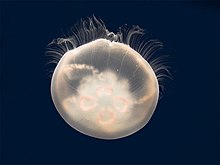
The presence of ocean blooms is usually seasonal, responding to prey availability and increasing with temperature and sunshine. Ocean currents tend to congregate jellyfish into large swarms or "blooms", consisting of hundreds or thousands of individuals. In addition to sometimes being concentrated by ocean currents, blooms can result from unusually high populations in some years. Bloom formation is a complex process that depends on ocean currents, nutrients, temperature, predation, and oxygen concentrations. Jellyfish are better able to survive in oxygen-poor water than competitors, and thus can thrive on plankton without competition. Jellyfish may also benefit from saltier waters, as saltier waters contain more iodine, which is necessary for polyps to turn into jellyfish. Rising sea temperatures caused by climate change may also contribute to jellyfish blooms, because many species of jellyfish are better able to survive in warmer waters.[17] Jellyfish are likely to stay in blooms that are quite large and can reach up to 100,000 in each.
There is very little data about changes in global jellyfish populations over time, besides "impressions" in the public memory. Scientists have little quantitative data of historic or current jellyfish populations.[14] Recent speculation about increases in jellyfish populations are based on no "before" data.
The global increase in jellyfish bloom frequency may stem from human impact. In some locations jellyfish may be filling ecological niches formerly occupied by now overfished creatures, but this hypothesis lacks supporting data.[14] Jellyfish researcher Marsh Youngbluth further clarifies that "jellyfish feed on the same kinds of prey as adult and young fish, so if fish are removed from the equation, jellyfish are likely to move in."[18]
Some jellyfish populations that have shown clear increases in the past few decades are "invasive" species, newly arrived from other habitats: examples include the Black Sea and the Caspian Sea, the Baltic Sea, the eastern Mediterranean coasts of Egypt and Israel, and the American coast of the Gulf of Mexico.[citation needed] Populations of invasive species can expand rapidly because there are often no natural predators in the new habitat to check their growth. Such blooms would not necessarily reflect overfishing or other environmental problems.
Increased nutrients, ascribed to agricultural runoff, have also been cited as an antecedent to the proliferation of jellyfish. Monty Graham, of the Dauphin Island Sea Lab in Alabama, says that "ecosystems in which there are high levels of nutrients ... provide nourishment for the small organisms on which jellyfish feed. In waters where there is eutrophication, low oxygen levels often result, favoring jellyfish as they thrive in less oxygen-rich water than fish can tolerate. The fact that jellyfish are increasing is a symptom of something happening in the ecosystem."[18]
By sampling sea life in a heavily fished region off the Namibian coast, total jellyfish biomass has overtaken that of fish, following intense fishing in the area in the last few decades.[19]
Areas which have been seriously affected by jellyfish blooms include the northern Gulf of Mexico, about which, Graham states, "Moon jellies have formed a kind of gelatinous net that stretches from end to end across the gulf."[18]
[edit] Detrimental effects
Jellyfish blooms cause problems for mankind. The most obvious are human stings (sometimes deadly) and tourism declines on coasts.
Other severe implications are destroying fish nets, poisoning or crushing captured fish, consuming fish eggs and young fish.[20]
Clogging also causes many problems including stoppage of nuclear power plants and desalination plants, as well as clogging engines of ships[20] and even overturning of boats by one of the largest species, the Nomura's jellyfish.
[edit] Life cycle
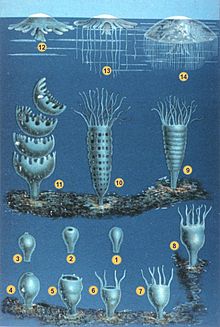
Most jellyfish undergo two distinct life history stages (body forms) during their life cycle. The first is the polypoid stage, when the animal takes the form of a small stalk with feeding tentacles; this polyp may be sessile, living on the bottom or on similar substrata such as floats or boat-bottoms, or it may be free-floating or attached to tiny bits of free-living plankton[21] or rarely, fish[22] or other invertebrates. Polyps generally have a mouth surrounded by upward-facing tentacles like miniatures of the closely related anthozoan polyps (sea anemones and corals), also of the phylum Cnidaria. Polyps may be solitary or colonial, and some bud asexually by various means, making more polyps. Most are very small, measured in millimeters.
In the second stage, the tiny polyps asexually produce jellyfish, each of which is also known as a medusa. Tiny jellyfish (usually only a millimeter or two across) swim away from the polyp and then grow and feed in the plankton.[citation needed] Medusae have a radially symmetric, umbrella-shaped body called a bell, which is usually supplied with marginal tentacles - fringe-like protrusions from the bell's border that capture prey. A few species of jellyfish do not have the polyp portion of the life cycle, but go from jellyfish to the next generation of jellyfish through direct development of fertilized eggs.
Jellyfish are dioecious; that is, they are usually either male or female (occasionally hermaphroditic specimens are found). In most cases, both release sperm and eggs into the surrounding water, where the (unprotected) eggs are fertilized and mature into new organisms. In a few species, the sperm swim into the female's mouth fertilizing the eggs within the female's body where they remain for the early stages of development. In moon jellies, the eggs lodge in pits on the oral arms, which form a temporary brood chamber for the developing planula larvae.
After fertilization and initial growth, a larval form, called the planula, develops. The planula is a small larva covered with cilia. It settles onto a firm surface and develops into a polyp. The polyp is cup-shaped with tentacles surrounding a single orifice, resembling a tiny sea anemone.[citation needed] After a growth interval, the polyp begins reproducing asexually by budding and, in the Scyphozoa, is called a segmenting polyp, or a scyphistoma. New scyphistomae may be produced by budding or new, immature jellies called ephyrae may be formed. A few jellyfish species can produce new medusae by budding directly from the medusan stage. Budding sites vary by species; from the tentacle bulbs, the manubrium (above the mouth), or the gonads of hydromedusae. A few of species of hydromedusae reproduce by fission (splitting in half).[21]
Other species of jellyfish are among the most common and important jellyfish predators, some of which specialize in jellies. Other predators include tuna, shark, swordfish, sea turtles and at least one species of Pacific salmon. Sea birds sometimes pick symbiotic crustaceans from the jellyfish bells near the sea's surface, inevitably feeding also on the jellyfish hosts of these amphipods or young crabs and shrimp.
Jellyfish lifespans typically range from a few hours (in the case of some very small hydromedusae) to several months. Life span and maximum size varies by species. One unusual species is reported to live as long as 30 years. Another species, Turritopsis dohrnii as T. nutricula, may be effectively immortal because of its ability to transform between medusa and polyp, thereby escaping death.[23] Most large coastal jellyfish live 2 to 6 months, during which they grow from a millimeter or two to many centimeters in diameter. They feed continuously and grow to adult size fairly rapidly. After reaching adult size, jellyfish spawn daily if there is enough food. In most species, spawning is controlled by light, so the entire population spawns at about the same time of day, often at either dusk or dawn.[24]
[edit] Importance to humans
[edit] Culinary uses
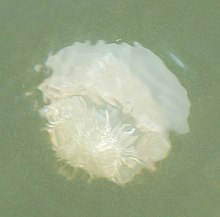
Only scyphozoan jellyfish belonging to the order Rhizostomeae are harvested for food; about 12 of the approximately 85 species are harvested and sold on international markets. Most of the harvest takes place in southeast Asia.[25] Rhizostomes, especially Rhopilema esculentum in China (Chinese name: Æ��È�� hçŽizhä�, meaning "sea sting") and Stomolophus meleagris (cannonball jellyfish) in the United States, are favored because of their larger and more rigid bodies and because their toxins are harmless to humans.[26]
Traditional processing methods, carried out by a Jellyfish Master, involve a 20 to 40 day multi-phase procedure in which after removing the gonads and mucous membranes, the umbrella and oral arms are treated with a mixture of table salt and alum, and compressed.[26] Processing reduces liquidation, off-odors and the growth of spoilage organisms, and makes the jellyfish drier and more acidic, producing a "crunchy and crispy texture."[26] Jellyfish prepared this way retain 7-10% of their original weight, and the processed product contains approximately 94% water and 6% protein.[26] Freshly processed jellyfish has a white, creamy color and turns yellow or brown during prolonged storage.
In China, processed jellyfish are desalted by soaking in water overnight and eaten cooked or raw. The dish is often served shredded with a dressing of oil, soy sauce, vinegar and sugar, or as a salad with vegetables.[26] In Japan, cured jellyfish are rinsed, cut into strips and served with vinegar as an appetizer.[26][27] Desalted, ready-to-eat products are also available.[26]
Fisheries have begun harvesting the American cannonball jellyfish, Stomolophus meleagris, along the southern Atlantic coast of the United States and in the Gulf of Mexico for export to Asia.[26]
[edit] In biotechnology
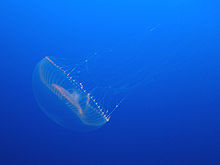
In 1961, Osamu Shimomura of Princeton University extracted green fluorescent protein (GFP) and another bioluminescent protein, called aequorin, from the large and abundant hydromedusa Aequorea victoria, while studying photoproteins that cause bioluminescence by this species of jellyfish. Three decades later, Douglas Prasher, a post-doctoral scientist at Woods Hole Oceanographic Institution, sequenced and cloned the gene for GFP. Martin Chalfie of Columbia University soon figured out how to use GFP as a fluorescent marker of genes inserted into other cells or organisms. Roger Tsien of University of California, San Diego, later chemically manipulated GFP in order to get other colors of fluorescence to use as markers. In 2008, Shimomura, Chalfie, and Tsien won the Nobel Prize in Chemistry for their work with GFP.
Man-made GFP is now commonly used as a fluorescent tag to show which cells or tissues express specific genes. The genetic engineering technique fuses the gene of interest to the GFP gene. The fused DNA is then put into a cell, to generate either a cell line or (via IVF techniques) an entire animal bearing the gene. In the cell or animal, the artificial gene turns on in the same tissues and the same time as the normal gene. But instead of making the normal protein, the gene makes GFP. One can then find out what tissues express that protein'or at what stage of development'by shining light on the animal or cell and observing fluorescence. The fluorescence shows where the gene is expressed.[28]
Jellyfish are also harvested for their collagen, which can be used for a variety of applications including the treatment of rheumatoid arthritis.
[edit] In captivity

Jellyfish are displayed in aquariums in many countries. Often the tank's background is blue and the animals are illuminated by side light, increasing the contrast between the animal and the background. In natural conditions, many jellies are so transparent that they are nearly invisible.
Jellyfish are not adapted to closed spaces. They depend on currents to transport them from place to place. Professional exhibits feature precise water flows, typically in circular tanks to prevent specimens from becoming trapped in corners. The Monterey Bay Aquarium uses a modified version of the kreisel (German for "spinning top") for this purpose. Jellyfish are becoming a popular trend in home aquariums. It is now possible to buy jellyfish aquariums and live jellyfish online.[29][30] It is also possible to assemble a jellyfish aquarium for personal use.[31]
[edit] Toxicity to humans
All jellyfish sting their prey using nematocysts, also called cnidocysts, stinging structures located in specialized cells called cnidocytes, which are characteristic of all Cnidaria. Contact with a jellyfish tentacle can trigger millions of nematocysts to pierce the skin and inject venom,[32] yet the sting of only some jellyfish species causes an adverse reaction in humans. When a nematocyst is triggered by contact by predator or prey, pressure builds up rapidly inside it up to 2,000 lbs/sq. inch until it bursts open. A lance inside the nematocyst pierces the victim's skin, and poison flows through into the victim.[33] Touching or being touched by a jellyfish can be very uncomfortable, sometimes requiring medical assistance; sting effects range from no effect to extreme pain to death. Because of the wide variation in response to jellyfish stings, it is wisest not to contact any jellyfish with bare skin. Even beached and dying jellyfish can still sting when touched.
Scyphozoan jellyfish stings are often uncomfortable, though not generally deadly, but some species of the class Cubozoa, or the Box jellyfish, such as the famous and especially toxic Irukandji, can be deadly. Stings may cause anaphylaxis, which may result in death. Hence, victims should immediately get out of the water. Medical care may include administration of an antivenom.
The three goals of first aid for uncomplicated jellyfish stings involve preventing injury to rescuers, deactivating the nematocysts, and removing tentacles attached to the patient. Rescuers should wear barrier clothing, such as panty hose, wet suits or full-body sting-proof suits. Deactivating the nematocysts, or stinging cells, prevents further injection of venom.
Vinegar (3 to 10% aqueous acetic acid) is a common remedy to help with box jellyfish stings,[34][35] but not the stings of the Portuguese Man o' War (which is not a true jellyfish, but a colony).[34] For stings on or around the eyes, a towel dampened with vinegar is used to dab around the eyes, with care taken to avoid the eyeballs. Salt water is also used if vinegar is unavailable.[34][36] Fresh water is not used if the sting occurrs in salt water, as changes in tonicity[37] can release additional venom. Rubbing wounds, or using alcohol, spirits, ammonia, or urine have strongly negative effects as these also encourage the release of venom.[38]
Clearing the area of jelly, tentacles, and wetness further reduces nematocyst firing.[38] Shaving the affected skin with a knife edge, safety razor, or credit card can remove remaining nematocysts.[39]
Beyond initial first aid, antihistamines such as diphenhydramine (Benadryl) can control skin irritation (pruritus).[39] For removal of venom in the skin, a paste of baking soda and water can be applied with a cloth covering on the sting.[citation needed] In some cases it is necessary to reapply paste every 15'20 minutes. Ice or fresh water is not be applied to the sting, as this may help the nematocysts to continue releasing their toxin.[40][41]
In 2010 at a New Hampshire beach, pieces of a single dead lion's mane jellyfish stung between 125 and 150 people.[42][43]
[edit] Jellyfish in the media
The new discoveries about jellyfish and their popularity as symbol of the beauty and fragility of the oceans are reflected on television in programs such as in "Jellyfish Invasion," which is an episode of the National Geographic Channel documentary series Explorer,[44][45][46] which includes research conducted by scientists in Australia, Hawaii and Japan.
Disney Pixar animated film Finding Nemo shows the near fatal effects of swimming through a jellyfish bloom.
[edit] Taxonomic classification systematics
Taxonomic classification systematics within the Cnidaria, as with all organisms, are always in flux. Many scientists who work on relationships between these groups are reluctant to assign ranks, although there is general agreement on the different groups, regardless of their absolute rank. Presented here is one scheme, which includes all groups that produce medusae (jellyfish), derived from several expert sources:
Phylum Cnidaria
- Subphylum Medusozoa
- Class Hydrozoa [47][48]
- Subclass Hydroidolina
-
- Order Anthomedusae (= Anthoathecata or Athecata)
- Order Leptomedusae (= Leptothecata or Thecata)
- Suborder Conica - see [47] for families
- Suborder Proboscoida - see [47] for families
- Order Siphonophorae
- Suborder Physonectae
- Families: Agalmatidae, Apolemiidae, Erennidae, Forskaliidae, Physophoridae, Pyrostephidae, Rhodaliidae
- Suborder Calycophorae
- Families: Abylidae, Clausophyidae, Diphyidae, Hippopodiidae, Prayidae, Sphaeronectidae
- Suborder Cystonectae
- Families: Physaliidae, Rhizophysidae
- Suborder Physonectae
-
- Subclass Trachylina
- Order Limnomedusae
-
-
- Families: Olindiidae, Monobrachiidae, Microhydrulidae, Armorhydridae
-
-
- Order Trachymedusae
-
-
- Families: Geryoniidae, Halicreatidae, Petasidae, Ptychogastriidae, Rhopalonematidae
-
-
- Order Narcomedusae
-
-
- Families: Cuninidae, Solmarisidae, Aeginidae, Tetraplatiidae
-
-
- Order Actinulidae
-
-
- Families: Halammohydridae, Otohydridae
-
-
- Order Limnomedusae
- Subclass Hydroidolina
- Class Staurozoa (= Stauromedusae) [49]
-
- Order Eleutherocarpida
-
-
- Families: Lucernariidae, Kishinouyeidae, Lipkeidae, Kyopodiidae
-
-
- Order Cleistocarpida
-
-
- Families: Depastridae, Thaumatoscyphidae, Craterolophinae
-
-
- Order Eleutherocarpida
-
- Class Cubozoa [50]
-
-
-
-
- Families: Carybdeidae, Alatinidae, Tamoyidae, Chirodropidae, Chiropsalmidae
-
-
-
-
- Class Scyphozoa [50]
-
- Order Coronatae
-
-
- Families: Atollidae, Atorellidae, Linuchidae, Nausithoidae, Paraphyllinidae, Periphyllidae
-
-
- Order Semaeostomeae
-
-
- Families: Cyaneidae, Pelagiidae, Ulmaridae
-
-
- Order Rhizostomeae
- Order Coronatae
-
- Class Hydrozoa [47][48]
[edit] Gallery
|
Pacific sea nettle jellyfish Chrysaora fuscescens. |
Upside-down jellyfish harbor algae in their tentacles which they turn up to the sun to promote photosynthesis. |
Chrysaora colorata, the purple-striped jellyfish, lives off the coast of Southern California. |
|
|
Lion's mane jellyfish, Cyanea capillata, the largest jellyfish, are known for its painful, but rarely fatal, sting. |
A species of Mediterranean jellyfish, Cotylorhiza tuberculata, on display at the Monterey Bay Aquarium. |
||
[edit] See also
| Wikimedia Commons has media related to: Scyphozoa |
| Wikimedia Commons has media related to: Jellyfish |
- Jellyfish dermatitis
- Turritopsis nutricula, an immortal jellyfish
- Sea nettle
- Irukandji jellyfish
- Moon jelly
- Phacellophora camtschatica
- Cubozoa (the box jellyfish)
- Cassiopea
- Cotylorhiza tuberculata
- Pelagia noctiluca (jellyfish mainly found in British water and Mediterranean)
- Craspedacusta sowerbyi, a freshwater jellyfish
- Lion's mane jellyfish, largest jellyfish, up to 120 feet long
- Portuguese Man o' War, commonly but erroneously thought of and referred to as jellyfish, actually a colony of organisms
- Ocean sunfish, predator of jellyfish
- Aequorea tenuis (the flat jellyfish)
[edit] References
- ^ Marques, A.C.; A. G. Collins (2004). "Cladistic analysis of Medusozoa and cnidarian evolution". Invertebrate Biology 123: 23'42. doi:10.1111/j.1744-7410.2004.tb00139.x.
- ^ Kramp, P.L. (1961). "Synopsis of the Medusae of the World". Journal of the Marine Biological Association of the United Kingdom 40: 1'469.
- ^ http://www.waterford-today.ie/index.php?option=com_content&task=view&id=933&Itemid=10177&ed=68
- ^ http://www.jellyfishfacts.net/mane-jellyfish.htm
- ^ http://www.redorbit.com/education/reference_library/cnidaria/lions_mane_jellyfish/4326/index.html
- ^ Flower Hat Jelly, New York Aquarium, retrieved Aug 2009.
- ^ Kelman, Janet Harvey; Rev. Theodore Wood (1910). The Sea-Shore, Shown to the Children. London: T. C. & E. C. Jack. pp. 146.
- ^ Klappenbach, Laura. "Ten Facts about Jellyfish". http://animals.about.com/od/cnidarians/a/tenfactsjellyfi.htm. Retrieved 24 January 2010.
- ^ "What are some determining characteristics of jellyfish in the class, Scyphozoa?". http://qanda.encyclopedia.com/question/some-determining-characteristics-jellyfish-class-scyphozoa-97854.html. Retrieved 24 January 2010.
- ^ Kaplan, Eugene H.; Kaplan, Susan L.; Peterson, Roger Tory (August 1999). A Field Guide to Coral Reefs: Caribbean and Florida. Boston : Houghton Mifflin. p. 55. ISBN 0-6180-0211-1. http://books.google.com/?id=OLYPWMoBkccC&pg. Retrieved 2009-08-31.
- ^ Haddock, S.H.D., and Case, J.F. (April 1999). "Bioluminescence spectra of shallow and deep-sea gelatinous zooplankton: ctenophores, medusae and siphonophores". Marine Biology 133: 571. doi:10.1007/s002270050497. http://www.lifesci.ucsb.edu/~haddock/abstracts/haddock_spectra.pdf. Retrieved 2009-09-09.
- ^ "Jellyfish Gone Wild" (Text of Flash). National Science Foundation. 3 March 2009. http://www.nsf.gov/news/special_reports/jellyfish/textonly/intro.jsp. Retrieved 17 November 2009. "In recent years, massive blooms of stinging jellyfish and jellyfish-like creatures have overrun some of the world's most important fisheries and tourist destinations.... Jellyfish swarms have also damaged fisheries, fish farms, seabed mining operations, desalination plants and large ships."
- ^ "Jellyfish Take Over an Over-Fished Area". 21 July 2006. http://www.npr.org/templates/story/story.php?storyId=5573968. Retrieved 19 November 2009.
- ^ a b c Mills, C.E. 2001. Jellyfish blooms: are populations increasing globally in response to changing ocean conditions? Hydrobiologia 451: 55-68.
- ^ Hamner, W. M.; P. P. Hamner, S. W. Strand (1994). "Sun-compass migration by Aurelia aurita (Scyphozoa): population retention and reproduction in Saanich Inlet, British Columbia.". Marine Biology 119: 347'356.. doi:10.1007/BF00347531.
- ^ Schuchert, Peter. "The Hydrozoa". http://www.ville-ge.ch/mhng/hydrozoa/hydrozoa-directory.htm. Retrieved 24 January 2010.
- ^ Shubin, Kristie (10 December 2008). "Anthropogenic Factors Associated with Jellyfish Blooms - Final Draft II". http://jrscience.wcp.muohio.edu/fieldcourses08/PapersMarineEcologyArticles/AnthropogenicFactorsAssocA.html. Retrieved 19 November 2009.
- ^ a b c The Washington Post, republished in the European Cetacean Bycatch Campaign, Jellyfish 'blooms' could be sign of ailing seas, May 6, 2002. Retrieved November 25, 2007.
- ^ Lynam, C. and six other authors, 2006. Jellyfish overtake fish in a heavily fished ecosystem. Current Biology 16, no. 13: R492-R493.
- ^ a b Jellyfish Gone Wild ' Text-only
- ^ a b Mills, C. E. (1987). "In situ and shipboard studies of living hydromedusae and hydroids: preliminary observations of life-cycle adaptations to the open ocean". Modern Trends in the Systematics, Ecology, and Evolution of Hydroids and Hydromedusae (Oxford: Clarendon Press).
- ^ Fewkes, J. Walter (1887). "A hydroid parasitic on a fish". Nature 36: 604'605. doi:10.1038/036604b0.
- ^ Piraino, S. et al. 1996. Reversing the life cycle: medusae transforming into polyps and cell transdifferentiation in Turritopsis nutricula (Cnidaria, Hydrozoa). Biological Bulletin 190: 302-312.
- ^ Mills, Claudia (1983). "Vertical migration and diel activity patterns of hydromedusae: studies in a large tank.". Journal of Plankton Research 5: 619'635. doi:10.1093/plankt/5.5.619.
- ^ Omori, M. and E. Nakano, 2001. Jellyfish fisheries in southeast Asia. Hydrobiologia 451: 19-26.
- ^ a b c d e f g h Y-H. Peggy Hsieh, Fui-Ming Leong, and Jack Rudloe (2004). "Jellyfish as food". Hydrobiologia 451 (1-3): 11'17. doi:10.1023/A:1011875720415. http://www.springerlink.com/content/x7204250k4174gwt/.
- ^ Firth, F.E. (1969). The Encyclopedia of Marine Resources. New York: Van Nostrand Reinhold Co.. New York. ISBN 0442223994.
- ^ Pieribone, V. and D.F. Gruber (2006). Aglow in the Dark: The Revolutionary Science of Biofluorescence. Harvard University Press. pp. 288p. http://www.hup.harvard.edu/catalog/PIEAGL.html.
- ^ Richtel, Matt (14 March 2009). "How to Avoid Liquefying Your Jellyfish". The New York Times. http://bits.blogs.nytimes.com/2009/03/14/how-to-avoid-liquefying-your-jellyfish/. Retrieved 6 May 2010.
- ^ http://www.airtranmagazine.com/features/2009/08/garage-brands
- ^ http://www.wikihow.com/Start-a-Jellyfish-Tank
- ^ Purves WK, Sadava D, Orians GH, Heller HC. 1998. Life.The Science of Biology. Part 4: The Evolution of Diversity. Chapter 31
- ^ http://www.jellyfishart.com/kb_results.asp?ID=11
- ^ a b c Fenner P, Williamson J, Burnett J, Rifkin J (1993). "First aid treatment of jellyfish stings in Australia. Response to a newly differentiated species". Med J Aust 158 (7): 498'501. doi:10.1023/A:1011875720415. PMID 8469205.
- ^ Currie B, Ho S, Alderslade P (1993). "Box-jellyfish, Coca-Cola and old wine". Med J Aust 158 (12): 868. doi:10.1023/A:1011875720415. PMID 8100984.
- ^ Yoshimoto C; Leong, Fui-Ming; Rudloe, Jack (2006). "Jellyfish species distinction has treatment implications". Am Fam Physician 73 (3): 391. doi:10.1023/A:1011875720415. PMID 16477882.
- ^ http://www.healthline.com/blogs/outdoor_health/2008/01/meat-tenderizer-for-jellyfish-sting.html
- ^ a b Hartwick R, Callanan V, Williamson J (1980). "Disarming the box-jellyfish: nematocyst inhibition in Chironex fleckeri". Med J Aust 1 (1): 15'20. doi:10.1023/A:1011875720415. PMID 6102347.
- ^ a b Perkins R, Morgan S (2004). "Poisoning, envenomation, and trauma from marine creatures". Am Fam Physician 69 (4): 885'90. doi:10.1023/A:1011875720415. PMID 14989575.
- ^ http://www.emedicinehealth.com/jellyfish_stings/page4_em.htm
- ^ http://www.healthcareask.com/first-aid/first-aid-5-7563.html
- ^ Ouch! Jellyfish stings 150 on N.H. beach, Boston Globe, July 21, 2010
- ^ Death Does Not Deter Jellyfish Sting, The New York Times, July 22, 2010
- ^ Jellyfish Invasion, National Geographic, retrieved Feb 2009.
- ^ Jellyfish Invasion, YouTube, retrieved Feb 2009.
- ^ Killer jellyfish population explosion warning, The Daily Telegraph, 11 Feb 2008, retrieved Feb 2009.
- ^ a b c d e Schuchert, Peter. "The Hydrozoa Directory". http://www.ville-ge.ch/mhng/hydrozoa/hydrozoa-directory.htm. Retrieved 2008-08-11.
- ^ Mills, C.E., D.R. Calder, A.C. Marques, A.E. Migotto, S.H.D. Haddock, C.W. Dunn and P.R. Pugh, 2007. Combined species list of Hydroids, Hydromedusae, and Siphonophores. pp. 151-168. In Light and Smith's Manual: Intertidal Invertebrates of the Central California Coast. Fourth Edition (J.T. Carlton, editor). University of California Press, Berkeley.
- ^ Mills, Claudia E. "Stauromedusae: List of all valid species names". http://faculty.washington.edu/cemills/Staurolist.html. Retrieved 2008-08-11.
- ^ a b Dawson, Michael N. "The Scyphozoan". http://thescyphozoan.ucmerced.edu/. Retrieved 2008-08-11.
[edit] External links
- Video of various Jellyfish species at the Monterey Bay Aquarium
- Scyphozoan Jellyfish
- Jellyfish and Other Gelatinous Zooplankton
- Jellyfish Facts - Information on Jellyfish and Jellyfish Safety
- Hydromedusae
- Stauromedusae / Staurozoa
- Information on Jellyfish as Pets
- Cotylorhiza tuberculata
- Treatment of Coelenterate and Jellyfish Envenomations
- British Marine Life Study Society - Jellyfish Page
- Jellyfish - Curious creatures of the sea
- Sting treatment
- Jellyfish Grown with Twelve Heads
- Jellyfish Boom Driven Partly by Warming Waters
- Jellyfish invasion of seacoast dead zones explained by anthropogenic estuarial pseudoeutrophication
Photos:
|
SOURCES.COM is an online portal and directory for journalists, news media, researchers and anyone seeking experts, spokespersons, and reliable information resources. Use SOURCES.COM to find experts, media contacts, news releases, background information, scientists, officials, speakers, newsmakers, spokespeople, talk show guests, story ideas, research studies, databases, universities, associations and NGOs, businesses, government spokespeople. Indexing and search applications by Ulli Diemer and Chris DeFreitas.
For information about being included in SOURCES as a expert or spokesperson see the FAQ . For partnerships, content and applications, and domain name opportunities contact us.










